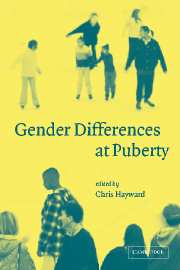Book contents
- Frontmatter
- Contents
- List of figures
- List of tables
- List of contributors
- Preface
- Acknowledgments
- 1 Methodological concerns in puberty-related research
- Part 1 Sex differences in hormones and their effect at puberty
- Part 2 Girls at puberty
- Part 3 Boys at puberty
- Part 4 Puberty and psychopathology
- 8 Puberty and depression
- 9 Puberty and schizophrenia
- Part 5 Pubertal timing: antecedents
- Part 6 Pubertal timing: consequences
- Part 7 Puberty and context
- Index
- References
8 - Puberty and depression
Published online by Cambridge University Press: 22 September 2009
- Frontmatter
- Contents
- List of figures
- List of tables
- List of contributors
- Preface
- Acknowledgments
- 1 Methodological concerns in puberty-related research
- Part 1 Sex differences in hormones and their effect at puberty
- Part 2 Girls at puberty
- Part 3 Boys at puberty
- Part 4 Puberty and psychopathology
- 8 Puberty and depression
- 9 Puberty and schizophrenia
- Part 5 Pubertal timing: antecedents
- Part 6 Pubertal timing: consequences
- Part 7 Puberty and context
- Index
- References
Summary
In this chapter we will examine evidence concerning the emergence of an excess of unipolar depression in females during adolescence. We will also present new data from the Great Smoky Mountains Study (GSMS) in support of an approach that combines consideration of both the endocrinology of puberty and the effects of stress on depression.
The phenomenon to be explained
Numerous adult studies from around the world have documented that women have 1.5 to 3 times more current and lifetime unipolar depression than men (Bebbington, et al., 1981; Bland, Newman, and Orn, 1988a; Bland, Newman, and Orn, 1988b; Blazer, et al., 1994; Canino, et al., 1987; Cheng, 1989; Hwu, Yeh, and Chang, 1989; Kessler, et al., 1994; Kessler, et al., 1993; Lee, Han, and Choi, 1987; Weissman, et al., 1993; Weissman, et al., 1996; Weissman and Klerman, 1977; Wells, et al., 1989; Wittchen, et al., 1992). In later life (after age 55), the female excess of depressions probably diminishes; mostly on account of falling rates in women (Bebbington, 1996; Bebbington, et al., 1998; Jorm, 1987).
Retrospective data from adults suggested that the female excess did not appear until adolescence (Burke, et al., 1990; Kessler, et al., 1993), and the child and adolescent epidemiological literature agrees that rates of unipolar depression in prepubertal girls are not higher than those in prepubertal boys (Anderson, et al., 1987; Angold, Costello, and Worthman, 1998; Angold, Costello, and Worthman, 1999; Angold and Rutter, 1992; Bird, et al.
Information
- Type
- Chapter
- Information
- Gender Differences at Puberty , pp. 137 - 164Publisher: Cambridge University PressPrint publication year: 2003
References
Accessibility standard: Unknown
Why this information is here
This section outlines the accessibility features of this content - including support for screen readers, full keyboard navigation and high-contrast display options. This may not be relevant for you.Accessibility Information
- 24
- Cited by
